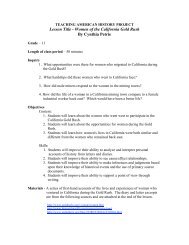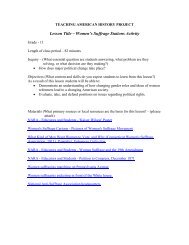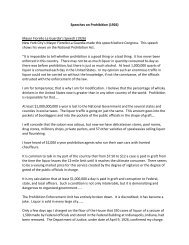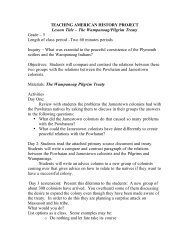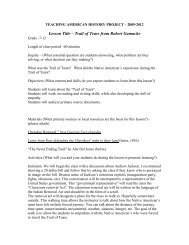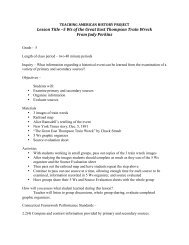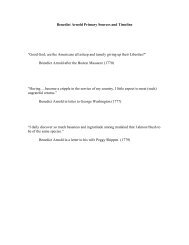Encounter with Christopher Columbus Lesson Plan - EastCONN
Encounter with Christopher Columbus Lesson Plan - EastCONN
Encounter with Christopher Columbus Lesson Plan - EastCONN
Create successful ePaper yourself
Turn your PDF publications into a flip-book with our unique Google optimized e-Paper software.
TEACHING AMERICAN HISTORY PROJECT<br />
<strong>Lesson</strong> Title – <strong>Encounter</strong> <strong>with</strong> <strong>Christopher</strong> <strong>Columbus</strong><br />
From Leslie Cicilline<br />
Grade – 5<br />
Length of class period –Two 60 minutes periods<br />
o Inquiry – How does the story of <strong>Columbus</strong> “discovering” America change<br />
when it is told from a different point of view?<br />
Objectives:<br />
• Students will deduce both European and Native American perspective of the<br />
European colonization of America.<br />
Materials:<br />
• Optical illusions<br />
• website for <strong>Columbus</strong>’s journal:<br />
• http://www.fordham.edu/halsall/source/columbus1.html (relevant entries attached)<br />
• <strong>Encounter</strong> by JaneYolen Harcourt Brace Jovanovich, Publishers; 1992<br />
• Graphic organizer - mindlook<br />
• Examples of partner poem<br />
Activities:<br />
Day One:<br />
• Ask students to look at the optical illusion. Discuss the two different<br />
perspectives.<br />
• Read aloud <strong>Encounter</strong> by Jane Yolen. Have student fill in a mind look <strong>with</strong> the<br />
thoughts/feelings of the Taino boy. Read the letter from the author.<br />
• Read together <strong>Columbus</strong>’s journal. Highlight important parts. Fill out another<br />
mind look <strong>with</strong> the thoughts/feelings of <strong>Christopher</strong> <strong>Columbus</strong>.<br />
Day 2: Show some examples of partner poems. In partners, have students use the ideas<br />
from their mindlooks to write a poem of two voices and share <strong>with</strong> the class.<br />
How will you assess what student learned during this lesson?<br />
• Mindlook<br />
• Partner poems<br />
Connecticut Framework Performance Standards –<br />
• Debate conflicting points of view on historical issues or events using evidence<br />
• Compare and contrast information provided by primary and secondary sources<br />
• Create written work from primary sources<br />
• Organize information in outlines and graphic organizers
• Identify and explain different points of view about a historical event<br />
• Describe views and feelings of people in the past using personal experiences<br />
and/or outside readings
Excerpts from <strong>Columbus</strong>’s Journal<br />
Thursday, 11 October. Steered west-southwest; and encountered a heavier<br />
sea than they had met <strong>with</strong> before in the whole voyage. Saw pardelas and a<br />
green rush near the vessel. The crew of the Pinta saw a cane and a log; they<br />
also picked up a stick which appeared to have been carved <strong>with</strong> an iron tool,<br />
a piece of cane, a plant which grows on land, and a board. The crew of the<br />
Nina saw other signs of land, and a stalk loaded <strong>with</strong> rose berries. These<br />
signs encouraged them, and they all grew cheerful. Sailed this day till sunset,<br />
twenty-seven leagues.<br />
After sunset steered their original course west and sailed twelve miles an<br />
hour till two hours after midnight, going ninety miles, which are twenty-two<br />
leagues and a half; and as the Pinta was the swiftest sailer, and kept ahead of<br />
the Admiral, she discovered land and made the signals which had been<br />
ordered. The land was first seen by a sailor called Rodrigo de Triana,<br />
although the Admiral at ten o'clock that evening standing on the quarterdeck<br />
saw a light, but so small a body that he could not affirm it to be land;<br />
calling to Pero Gutierrez, groom of the King's wardrobe, he told him he saw<br />
a light, and bid him look that way, which he did and saw it; he did the same<br />
to Rodrigo Sanchez of Segovia, whom the King and Queen had sent <strong>with</strong> the<br />
squadron as comptroller, but he was unable to see it from his situation. The<br />
Admiral again perceived it once or twice, appearing like the light of a wax<br />
candle moving up and down, which some thought an indication of land. But<br />
the Admiral held it for certain that land was near; for which reason, after<br />
they had said the Salve which the seamen are accustomed to repeat and<br />
chant after their fashion, the Admiral directed them to keep a strict watch<br />
upon the forecastle and look out diligently for land, and to him who should<br />
first discover it he promised a silken jacket, besides the reward which the<br />
King and Queen had offered, which was an annuity of ten thousand<br />
maravedis. At two o'clock in the morning the land was discovered, at two<br />
leagues' distance; they took in sail and remained under the square-sail lying<br />
to till day, which was Friday, when they found themselves near a small<br />
island, one of the Lucayos, called in the Indian language Guanahani.
Presently they descried people, naked, and the Admiral landed in the boat,<br />
which was armed, along <strong>with</strong> Martin Alonzo Pinzon, and Vincent Yanez his<br />
brother, captain of the Nina. The Admiral bore the royal standard, and the<br />
two captains each a banner of the Green Cross, which all the ships had<br />
carried; this contained the initials of the names of the King and Queen each<br />
side of the cross, and a crown over each letter Arrived on shore, they saw<br />
trees very green many streams of water, and diverse sorts of fruits. The<br />
Admiral called upon the two Captains, and the rest of the crew who landed,<br />
as also to Rodrigo de Escovedo notary of the fleet, and Rodrigo Sanchez, of<br />
Segovia, to bear witness that he before all others took possession (as in fact<br />
he did) of that island for the King and Queen his sovereigns, making the<br />
requisite declarations, which are more at large set down here in writing.<br />
Numbers of the people of the island straightway collected together. Here<br />
follow the precise words of the Admiral: "As I saw that they were very<br />
friendly to us, and perceived that they could be much more easily converted<br />
to our holy faith by gentle means than by force, I presented them <strong>with</strong> some<br />
red caps, and strings of beads to wear upon the neck, and many other trifles<br />
of small value, where<strong>with</strong> they were much delighted, and became<br />
wonderfully attached to us. Afterwards they came swimming to the boats,<br />
bringing parrots, balls of cotton thread, javelins, and many other things<br />
which they exchanged for articles we gave them, such as glass beads, and<br />
hawk's bells; which trade was carried on <strong>with</strong> the utmost good will. But they<br />
seemed on the whole to me, to be a very poor people. They all go completely<br />
naked, even the women, though I saw but one girl. All whom I saw were<br />
young, not above thirty years of age, well made, <strong>with</strong> fine shapes and faces;<br />
their hair short, and coarse like that of a horse's tail, combed toward the<br />
forehead, except a small portion which they suffer to hang down behind, and<br />
never cut. Some paint themselves <strong>with</strong> black, which makes them appear like<br />
those of the Canaries, neither black nor white; others <strong>with</strong> white, others <strong>with</strong><br />
red, and others <strong>with</strong> such colors as they can find. Some paint the face, and<br />
some the whole body; others only the eyes, and others the nose. Weapons<br />
they have none, nor are acquainted <strong>with</strong> them, for I showed them swords<br />
which they grasped by the blades, and cut themselves through ignorance.<br />
They have no iron, their javelins being <strong>with</strong>out it, and nothing more than<br />
sticks, though some have fish-bones or other things at the ends. They are all<br />
of a good size and stature, and handsomely formed. I saw some <strong>with</strong> scars of<br />
wounds upon their bodies, and demanded by signs the of them; they<br />
answered me in the same way, that there came people from the other islands<br />
in the neighborhood who endeavored to make prisoners of them, and they<br />
defended themselves. I thought then, and still believe, that these were from
the continent. It appears to me, that the people are ingenious, and would be<br />
good servants and I am of opinion that they would very readily become<br />
Christians, as they appear to have no religion. They very quickly learn such<br />
words as are spoken to them. If it please our Lord, I intend at my return to<br />
carry home six of them to your Highnesses, that they may learn our<br />
language. I saw no beasts in the island, nor any sort of animals except<br />
parrots." These are the words of the Admiral.<br />
Saturday, 13 October. "At daybreak great multitudes of men came to the<br />
shore, all young and of fine shapes, very handsome; their hair not curled but<br />
straight and coarse like horse-hair, and all <strong>with</strong> foreheads and heads much<br />
broader than any people I had hitherto seen; their eyes were large and very<br />
beautiful; they were not black, but the color of the inhabitants of the<br />
Canaries, which is a very natural circumstance, they being in the same<br />
latitude <strong>with</strong> the island of Ferro in the Canaries. They were straight-limbed<br />
<strong>with</strong>out exception, and not <strong>with</strong> prominent bellies but handsomely shaped.<br />
They came to the ship in canoes, made of a single trunk of a tree, wrought in<br />
a wonderful manner considering the country; some of them large enough to<br />
contain forty or forty-five men, others of different sizes down to those fitted<br />
to hold but a single person. They rowed <strong>with</strong> an oar like a baker's peel, and<br />
wonderfully swift. If they happen to upset, they all jump into the sea, and<br />
swim till they have righted their canoe and emptied it <strong>with</strong> the calabashes<br />
they carry <strong>with</strong> them. They came loaded <strong>with</strong> balls of cotton, parrots,<br />
javelins, and other things too numerous to mention; these they exchanged for<br />
whatever we chose to give them. I was very attentive to them, and strove to<br />
learn if they had any gold. Seeing some of them <strong>with</strong> little bits of this metal<br />
hanging at their noses, I gathered from them by signs that by going<br />
southward or steering round the island in that direction, there would be<br />
found a king who possessed large vessels of gold, and in great quantities. I<br />
endeavored to procure them to lead the way thither, but found they were<br />
unacquainted <strong>with</strong> the route. I determined to stay here till the evening of the<br />
next day, and then sail for the southwest; for according to what I could learn<br />
from them, there was land at the south as well as at the southwest and<br />
northwest and those from the northwest came many times and fought <strong>with</strong><br />
them and proceeded on to the southwest in search of gold and precious<br />
stones. This is a large and level island, <strong>with</strong> trees extremely flourishing, and<br />
streams of water; there is a large lake in the middle of the island, but no<br />
mountains: the whole is completely covered <strong>with</strong> verdure and delightful to<br />
behold. The natives are an inoffensive people, and so desirous to possess any<br />
thing they saw <strong>with</strong> us, that they kept swimming off to the ships <strong>with</strong>
whatever they could find, and readily bartered for any article we saw fit to<br />
give them in return, even such as broken platters and fragments of glass. I<br />
saw in this manner sixteen balls of cotton thread which weighed above<br />
twenty-five pounds, given for three Portuguese ceutis. This traffic I forbade,<br />
and suffered no one to take their cotton from them, unless I should order it to<br />
be procured for your Highnesses, if proper quantities could be met <strong>with</strong>. It<br />
grows in this island, but from my short stay here I could not satisfy myself<br />
fully concerning it; the gold, also, which they wear in their noses, is found<br />
here, but not to lose time, I am determined to proceed onward and ascertain<br />
whether I can reach Cipango. At night they all went on shore <strong>with</strong> their<br />
canoes.
Other Related Primary Sources<br />
• As a reward for his successful voyage of discovery, the Spanish sovereigns<br />
granted <strong>Columbus</strong> the right to bear arms. According to the blazon specified in<br />
letters patent dated May 20, 1493, <strong>Columbus</strong> was to bear in the first and the<br />
second quarters the royal charges of Castile and Leon -- the castle and the lion --<br />
but <strong>with</strong> different tinctures or colors. In the third quarter would be islands in a<br />
wavy sea, and in the fourth, the customary arms of his family.
The earlist graphic representation of <strong>Columbus</strong>'s arms is found in his Book of<br />
Privileges and shows the significant modifications <strong>Columbus</strong> ordered by his own<br />
authority. In addition to the royal charges that were authorized in the top quarters,<br />
<strong>Columbus</strong> adopted the royal colors as well, added a continent among the islands<br />
in the third quarter, and for the fourth quarter borrowed five anchors in fess from<br />
the blazon of the Admiral of Castille. <strong>Columbus</strong>'s bold usurpation of the royal<br />
arms, as well as his choice of additional symbols, help to define his personality<br />
and his sense of the significance of his service to the Spanish monarchs.<br />
• Book of Privileges<br />
The Book of Privileges is a collection of agreements between <strong>Columbus</strong> and the<br />
crowns of Spain prepared in Seville in 1502 before his 4th final voyage. The<br />
compilation of documents includes the 1497 confirmation of the rights to titles<br />
and profits granted to the Admiral by the 1492 contract of Santa Fe and<br />
augmented in 1493 and 1494, as well as routine instructions and authorizations<br />
related to his third voyage. We know that four copies of his Book of Privileges<br />
existed in 1502, three written on vellum and one on paper.<br />
All three vellum copies have thirty-six documents in common, including the Papal<br />
Bull inter caetera of May 4, 1493, defining the line of demarcation of future<br />
Spanish and Portuguese explorations, and specifically acknowledging <strong>Columbus</strong>'s<br />
contributions. The bull is the first document on vellum in the Library's copy and<br />
the thirty-sixth document in the Genoa and the Paris codices. The Library copy<br />
does not have the elaborate rubricated title page, the vividly colored <strong>Columbus</strong><br />
coat of arms, or the authenticating notarial signatures contained in the other<br />
copies. The Library's copy, however, does have a unique transcription of the<br />
Papal Bull Dudum siquidem of September 26, 1493, extending the Spanish<br />
donation. The bull is folded and addressed to the Spanish sovereigns.




